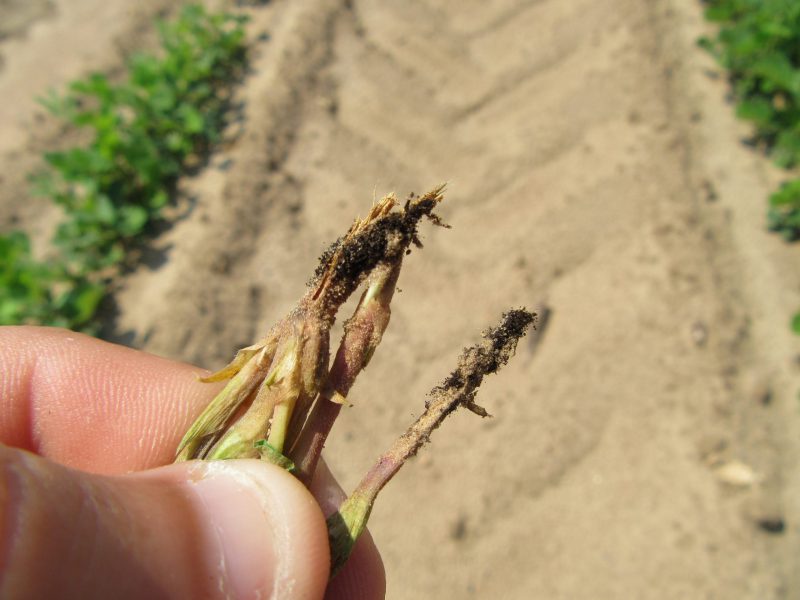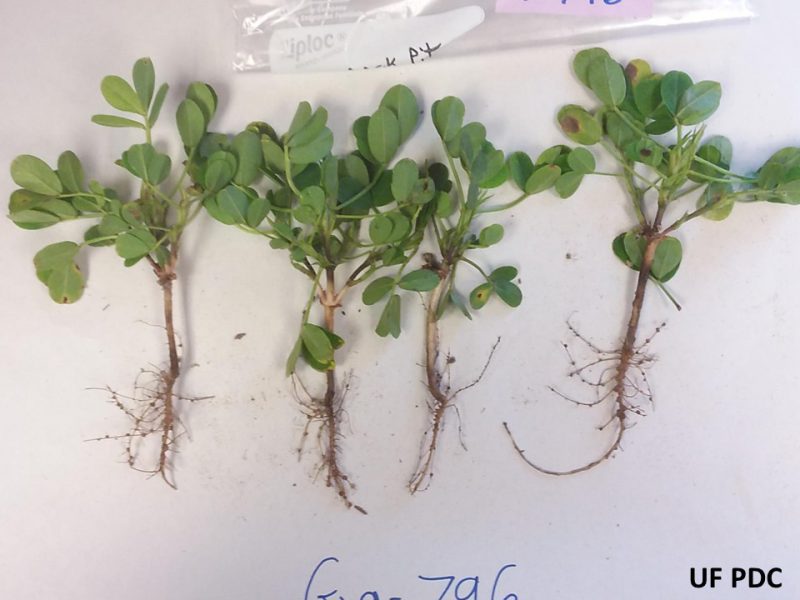Mark Mauldin, Ag & Natural Resources Agent Washington County, Ethan Carter, Regional Crop IPM Agent, Dr. Barry Tillman Peanut Breeder UF/IFAS NFREC, and Camila Ichazo
The Panhandle peanut crop ranges in age from peanuts that have started blooming and are receiving gypsum applications to fields that have just been planted. Some growers are seeing younger peanuts that are starting to display chemical injury, especially after the recent and much needed rainy weather.
Thimet and Valor have both been associated with injury on young plants. If one or both chemicals were used at planting, its possible for plants to experience injury from cracking through the first several weeks after emergence. Generally, the crop grows out of both types of injury with minimal yield loss.
–
Thimet
For Thimet, greater risk of injury is associated with weather conditions (or other plant stressors) that impacts the plant’s ability to metabolize the product. Light and sandy soils with little organic matter can have higher risks of Thimet burn. After the recent rains, most fields should have good moisture in the root zone which should encourage Thimet uptake, making future injury possible if the plant becomes stressed. Thimet burn is general not associated with significant yield loss.
–
Valor
Fields where Valor was applied are likely to exhibit injury, if they receive rainfall or irrigation from cracking through the first few weeks after emergence. The injury occurs because the chemical is splashed from the soil on to the young plants. The plants nearly always grow out of this injury with no significant yield loss.
–
Chemical injury should not be confused with seedling disease. Chemical jury and seedling diseases can be quickly distinguished by observing the location of the damage. Seedling diseases will usually be evident on the plant stem, at or below the soil surface while chemical injury associated with Thimet and Valor is observed on the leaves. When seedling diseases are the culprit, the plant stem is usually compromised, looking shriveled/rotted and possibly possessing fungal spores. The most common seedling diseases include pythium, rhizoctonia, and crown rot (aspergillus niger). See include pictures and/or contact your County’s Agriculture Extension Agent for help identifying the cause of any issues you may be seeing.
–

Aspergillus crown rot on peanut showing the black spores produced by the fungus. (Credit: E. Carter)
–
aGDD Tracker for the Florida Peanut Producing Region – 6/11/21 edition
The aGDD Tracker is compiled from data generated by PeanutFARM.org. The dark blue bars in the cells with the aGDD values indicates progress towards 2500 aGDDs. The extends to the right as aGDDs are accumulated. The entire cell will be dark blue when a field has accumulated 2500 aGDDs. It is recommended that fields be sampled and exact days-to-harvest be determined via pod-blasting once a field reaches 2300 aGDDs.
–
Due to the Memorial Day Holiday, it’s been three weeks since we have published an updated aGDD Tracker. In that time the fields have accumulated a lot of aGDDs, it’s obvious that the growing season is in full swing and temperatures have warmed up. The last time the aGDD Tracker was published, the earliest planted fields (planted 3/17) averaged 674 aGDDs. At 64 days after planting that equaled approximately 10.5 aGDDs per calendar day. As of 6/11 those same fields averaged 1006 aGDDs. At 86 days after planting that equals approximately 11.6 aGDDs per calendar day. The rate of accumulation is increasing; more heat means more rapid accumulation of aGDDs. This same concept is shown when you compare the different planting dates; all of the fields planted 4/7 or later are averaging over 13 aGDDs per calendar day. These fields have had warm soil and air temperatures the entire time they have been in the ground, so they have accumulated aGDDs slightly faster than the earlier planted fields.
The only thing restricting the fields’ rapid progress toward maturity is adequate availability of moisture. For the three locations with both rain fed and irrigated fields (again looking at the earliest planted fields), the irrigated fields are 174 aGDDs ahead of the rain fed fields on average. As you would expect the difference is greater in areas that have been drier, with Citra being the most notable (207 aGDD difference).
Use the Tracker to approximate how your fields are progressing by following the fields on the Tracker that are the most similar to yours in terms of planting date, location and irrigation status. For more precise tracking of your fields got to PeanutFARM.org and set up your fields in the system. You will be able to enter field specific rainfall/irrigation data and soil type. Temperature data will come from the closest FAWN weather station.
–
- Improve Your Pasture Management this Spring - April 19, 2024
- Plant Now for the Panhandle Watermelon Festival Big Melon Contest & New Junior Jubilee Kid’s Contest - March 8, 2024
- Central Panhandle Pesticide Applicator Training Series – February 12-15 - January 19, 2024




